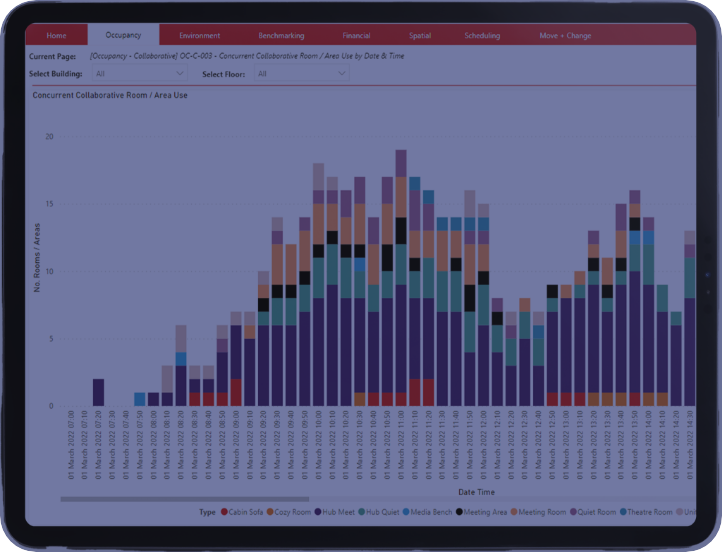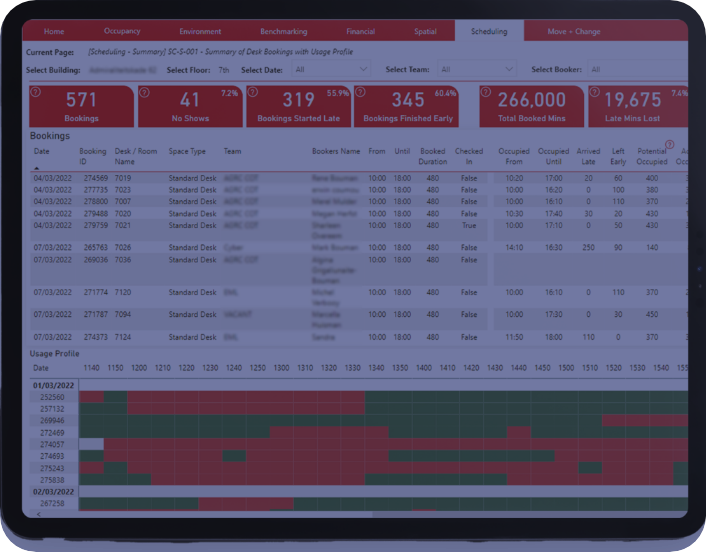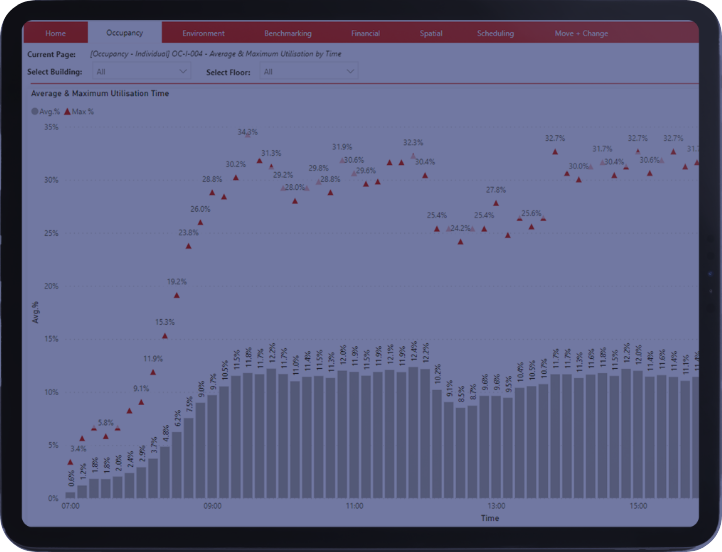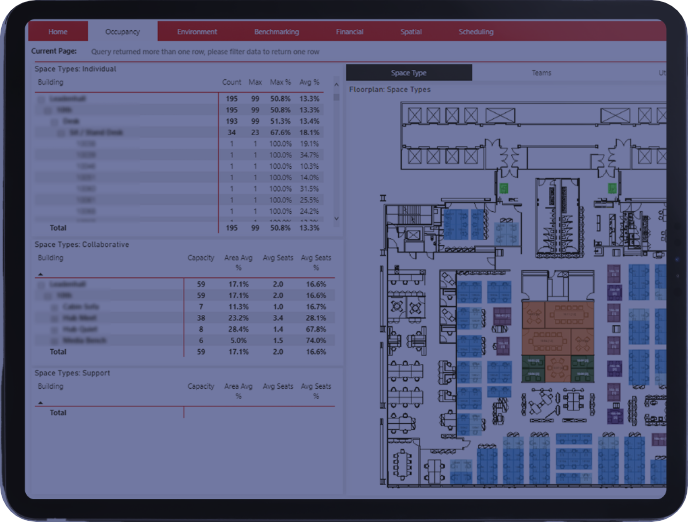Executive summary
With the hybrid workplace now a reality, the Ultimate Guide to Space Utilization by NFS is designed to show leaders how to capture and use data to shape the working environment, creating great productivity, collaboration, wellbeing and talent retention.
Drawing on real-life examples from organizations around the world, it reveals:
- How data closes the gap between what you think about space utlization – and what’s reality
- Best practice – real life success stories
- 4 key benefits of supporting your hybrid working strategy with technology.
- What types of data you need to capture and analyze
- The elements of the technology toolkit you need to do it
- What good data looks like – and what you can achieve with it (with real-world examples)
- Your action checklist for success
- What you should do next – and how to find help.
Then you will learn:
The Ultimate Guide from NFS Technology
Space Utilization – Challenge Or Opportunity?
Space has always been one of the biggest business costs – but it’s never been the red hot talking point it is now.
- A survey by AWA of 80,000 employees found they are only spending 1.4 days a week in the office.
- Apple has had to mandate its staff to come into HQ three days a week.
- The Future of Work report by AT&T shows hybrid working will be the default by 2024 – yet 72% of businesses lack a detailed strategy.
So what are they getting right?
These organizations have a clear end-to-end view of how their people are REALLY using their entire space, with data captured day to day, hour to hour, even minute to minute.
Download guide
Space use – how data closes the gap between perception and reality
Clipboard surveys are inaccurate
Staff often wrongly believe they use their desk 100% of the time, for instance.
Real life example:
When one organization asked how many people attend the office on a Monday, 30% said yes – but sensors showed only 10% really did
Space is often not used as booked
E.g. only four people attend instead of eight.
Real life example:
A large company wanted to install meeting pods for 6-8 people – but when data was captured over several months, it showed nearly all meetings were 4 or fewer.
“Just in case” thinking drives over-booking
People overestimate their needs.
Real life example:
A major global financial believed it had a small meeting room shortage. Data capture showed part of the problem was that staff were booking small meeting rooms for full days but using them for only 2 hours.
Occupancy patterns are hard to track manually
Since the return to work, people have favored working from home on different days of the week. You need data in real time, all the time, not just a snapshot.
Real life example:
A major US financial wanted to track how different teams used desks on different days, but many people weren’t checking in and out. Desk panels automated the process, capturing the required data and also improving the employee experience.
Hybrid working – 4 benefits of a data-supported strategy

Luis De Souza,
CEO of NFS Technology, says:
“It’s alarming to see that so many organizations are finding their way into the hybrid working world without a robust strategy supported by data and technology.
Without a hybrid strategy, space is utilized ad hoc. That creates inefficiency and a poor employee experience where productivity, wellbeing and talent retention collapse. The organization misses out on opportunities to support its agile workforce, streamline operations, reduce admin and rationalise real estate costs.”
The benefits of a well thought out strategy include:
The benefits of a well thought out strategy include:
More efficient use of space
Tailored to meet the needs of your agile workforce, with lower environmental impact
An enhanced employee experience
Better collaboration, wellbeing and talent retention
Rationalized real estate costs
Possibilities for downsizing, or if you are on a long lease, for repurposing unused areas e.g. converting space into a externally-available conference venue
Improved productivity
Less time wasted on admin and unnecessary travel means operations are streamlined
4 burning questions workplace leaders ask NFS
- How do I understand my space and what my workers need from it?
- How can I discover how my agile users are interacting with workspace in real time?
- How do I use data to plan for the best use of the space?
- How do I design in the flexibility to deal with the evolving needs of my business and my workers?
Why a workspace management ecosystem is the solution
With desk and room booking at its core, integrated with supporting technologies including occupancy sensors, desk panels and digital signage, a workspace management system provides:
- A great employee experience
Agile staff use a mobile app to find and book workspace, locate colleagues for collaboration, organize meetings quickly even in multiple locations, and check in and out of space touch-free with QR codes.
- A VIP welcome
Visitors are welcomed safely and securely and guided to the right destination by wayfinding digital signage.
- Robust decisions
Granular information is captured at every stage – making every decision data-supported.
- Better space utilization
Desks and meeting rooms can be configured to match requirements.
- Real estate and energy savings
Unused floor space can be minimized – areas unused on certain days can be powered down.
What the integrated hybrid workplace looks like
Technology in Action
Best practice – the full stories
Sensor success:
Major global financial uses sensors to solve meeting room crisis
Staff attending the client’s HQ were finding small meeting rooms unavailable. Data captured by room sensors integrated with the Rendezvous booking system revealed that:
- PAs booked smaller meeting rooms for visiting senior staff, just in case
- Staff attending collaboration sessions also booked small meeting and client rooms
- Smaller rooms were booked for the day but used for less than 2 hours.
What they did
- If a small room is not in use by 10am and used for at least 2 hours the booking is automatically cancelled. This released over 40% of previously booked blocked space.
- Small meeting rooms in collaboration areas are only bookable for 2 hours using a room panel.
- Some larger meeting rooms with low utilization rates were converted into smaller ones.
Key learning:
Data driven decision-making is instrumental to securing effective workplace change.
Sensor Factsheet
Utilization data
Top international law firm plans future of hybrid working

Global legal firm Bryan Cave Leighton Paisner wanted its 25 offices to have easy control of meeting rooms across the whole estate, and needed detailed data on usage for planning. The organization rolled out Rendezvous Workspace.

Global legal firm Bryan Cave Leighton Paisner wanted its 25 offices to have easy control of meeting rooms across the whole estate, and needed detailed data on usage for planning. The organization rolled out Rendezvous Workspace.
What they did
- Sensor technology in London and Manchester to track space utilization in real-time .
- Digital room panels for meeting rooms and smaller panels for flexible areas.
- Hot desking and reverse hoteling, making allocated desks available when people are away.
- Touch-free check in and out for unallocated seating, booked via a mobile app.
Key learning:
Accurate data enables maximum utilization across a global estate
Agile space success
Epsom and St Helier NHS Trust supports 5,000 staff and spaces

Moving to agile working, the Trust needed to organize space well for its staff across two hospitals and community services.

Moving to agile working, the Trust needed to organize space well for its staff across two hospitals and community services.
- Using Rendezvous Workspace room and resource scheduling technology staff can now find and book the rooms they need
- Availability of meeting rooms, lecture halls and hot desking areas is now easily visible
- Staff can use the system to organize meetings easily, without tedious admin
- Data capture provides insight into space utilization across the whole estate in real time
Key learning:
Ease of space booking enables agile working, while data capture provides control
Collaboration success
Legal giant uses color-coding to boost working together

A British-based law firm with offices in several global locations uses its Rendezvous Workspace desk scheduling system to help colleagues collaborate effectively.

A British-based law firm with offices in several global locations uses its Rendezvous Workspace desk scheduling system to help colleagues collaborate effectively.
- ‘Neighborhoods’ are color-coded on a graphical floor plan so workers can see where to book space close to collaborating colleagues
- Desk booking is done via an app in seconds
- Resources such as parking can be booked in the same transaction
- Utilization data provides key information for planning
Key learning:
Collaboration opportunities can be enhanced in the hybrid workplace by easy-to-view desk booking
Space repurposing success
Major US financial discovers desk panel power
The organization wanted to to make it easy for staff to book a space to return to the office, and needed to track actual desk utilization to provide data to support their space repurposing plans. Specifically, they needed to track how desks were used by different teams on different days of the week.
- Rendezvous space booking provided a mobile app for floorplan-based desk and room booking, which was enthusiastically adopted by staff to find space and colleagues.
- A significant number were not using QR codes to log into the space, making it a challenge to track space used. The solution was to deploy desk panels that automatically check people in and out of desks.
- Integration between the Rendezvous booking platform and the desk panels delivered the staff experience the company required, and also the data to make informed space planning decisions.
The 7 types of data you need to capture
- Desk and meeting room occupancy in real time – so you can see how they are being used
- Space use by day of week – so you can spot patterns and respond
- Type of space booked – to ensure you have the right amount of each type
- Purpose the space is used for – to determine whether activities are properly supported
- Dynamic of the staff using the spaces – different groups may have different needs: new staff might appreciate face-to-face working for mentoring, but staff with families might enjoy the flexibility of home working
- People density in real time – to meet health and safety requirements
- Visitor data – to understand demand for space shared with external guests
Your technological toolkit for data insights
The fully integrated workplace management ecosystem
Meeting room/desk booking app
- Staff find and book space via an app, using a graphical floor plan that also locates colleagues
- They can organize meetings, invite attendees and add services such as catering using the app, even in multiple locations and time zones
- All changes are notified automatically to everyone involved
Sensors
- Supply data on space usage so you can repurpose where needed
- Replace time consuming and inaccurate surveys
- Types of space that can be tracked include rooms/desks/cubicles/footfall/parking
- Types of sensor activity include utilization/occupancy/heatmaps/CO2/temperature/noise/humidity/air quality
Integrated technologies
- Digital signage for wayfinding
- Room and desk panels for touch free check in with QR codes, and in-room meeting changes
Comprehensive reporting and analysis
- Enable you to interpret and use the real-time data easily
Meeting room/desk booking app
- Staff find and book space via an app, using a graphical floor plan that also locates colleagues
- They can organize meetings, invite attendees and add services such as catering using the app, even in multiple locations and time zones
- All changes are notified automatically to everyone involved
Sensors
- Supply data on space usage so you can repurpose where needed
- Replace time consuming and inaccurate surveys
- Types of space that can be tracked include rooms/desks/cubicles/footfall/parking
- Types of sensor activity include utilization/occupancy/heatmaps/CO2/temperature/noise/humidity/air quality
Integrated technologies
- Digital signage for wayfinding
- Room and desk panels for touch free check in with QR codes, and in-room meeting changes
Comprehensive reporting and analysis
- Enable you to interpret and use the real-time data easily
What does good data look like?
Collaborative room/area use:
See at a glance how much space is being booked and used for collaboration throughout the day
Desk booking/usage:
Compare specific desks booked with actual usage and see valuable statistics on no shows and other data
Collaborative room/area use:
See at a glance how much space is being booked and used for collaboration throughout the day
Collaborative room/area use:
See at a glance how much space is being booked and used for collaboration throughout the day
Desk booking/usage:
Compare specific desks booked with actual usage and see valuable statistics on no shows and other data
Collaborative room/area use:
See at a glance how much space is being booked and used for collaboration throughout the day
What can you achieve with great space data?
See these real-life examples
Cost savings
A leading financial services firm was able to consolidate two buildings into one, resulting in $500,000 annual savings, after utilization data gave a clear picture of how the space was being used.
Source: CBRE Global Occupancy Insights
Productivity
Over two-fifths of employers told a survey at the end of 2021 that home and hybrid working have increased productivity.
Source: CIPD
Employee experience
“A more fair employee experience improves employee performance by up to
26% and employee retention by up to 27%.”
Source: GARTNER – How to Foster A More Fair Employee Experience
Real estate
Companies implementing hybrid working and using flexible office space are saving
on traditionally fixed overhead costs including rent, heating and support staff to the tune of £8,100 per employee.
Source: Business Insider magazine
Employee savings
Hybrid working can save employees an average of £328 on train travel per month and £128 by car.
Environment
Allowing workers to work from home some of the time can reduce nitrogen emissions from car exhausts by up to 10%.
Your action checklist
- Select a technology provider with a proven track record and a consultative approach to your needs.
- Get everyone involved from the start – to ensure buy-in, you need to communicate the benefits of capturing data to your employees.
- Set clear goals. Your provider will help you identify the outcomes you require and create an integrated solution that achieves them.
What our clients say
Rendezvous is the choice of many leading organizations looking for a flexible booking solution which can be deployed rapidly.
“Since the initial global implementation, our scope has expanded and we've continued working with NFS to modernise a new building with panel technology and implement hot-desking. We're now able to utilise the software to support our return to work strategy. The commitment, flexibility and expertise of our consultant has allowed for seamless transitions and I look forward to seeing where this technology takes us in the future”
Read MoreSharyn El Amir
Senior IS Project Manager, Bryan Cave Leighton Paisner
“The deployment went extremely smoothly, and the system is providing exactly what we needed. It has helped us to enhance our working environment and create the right conditions where our agile staff can work productively and collaborate together with great efficiency.”
Read MoreAkif Rawn
Deputy Director of IT, Lewisham and Greenwich NHS Trust
“Rendezvous has enabled us to bring the booking and management of space into a single platform. We were previously using Outlook and other tools to do this with mixed results and no real management information. We now have important information like space utilisation data and our staff have the tools to book space. This was particularly important in the return to the office strategy, as it supports our safe and structured return to the office plan.”
Read MoreDavid Balding
Head of Facilities, Epping Forest District Council
“The room booking system has contributed to the journey the Trust has started in moving forward to a more agile working environment. It has allowed to Trust to better use its space and increase utilization of the meeting rooms. Now the Trust has started the agile working journey, it will look to consolidate and improve space utilization while improving the working environment.”
Read MoreTerry Murphy
Assistant Director of Property at the Epsom and St Helier NHS Trust
NFS – why we are your preferred technology partner
We are respected international providers of market-leading digital technology and services for the workspace, hospitality and venue industries, with more than 1800 satisfied customers in over 35 countries – including many leading household name brands. We pride ourselves on offering an understanding and consultative approach.
Backed by an expert 24/7 helpdesk, our solutions help organizations support their hybrid workforces better, manage venues more efficiently and streamline their hospitality operations while enhancing their customer service operations.
We treasure our clients and partners, and develop long-term relationships with them – more than 60% have been with us for more than ten years.
So ask NFS
We’ve decades of experience helping organizations all over the world transform their workplaces, make the most of their real estate and create an engaging and enjoyable employee experience.
Our experts are ready and waiting to help
Book a demo


